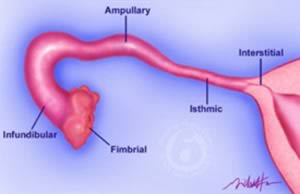Avoiding Essure Complications
During Essure Removal
Avoiding leaving Essure fragments during Essure removal requires awareness of the anatomic variations of the interstitial portion of the fallopian tube.
Anatomic variations may contribute to increased difficulty with some Essure insertions, be the cause for some Essure complications, and may increase the difficulty of intact micro-insert removal.
Anatomic variations in the interstitial portion of the tube will result in micro-inserts having different positions and courses of travel within the myometrium.
The interstitial portion of the fallopian tube travels through the uterine wall and is variable in length, angle, and curvature. Two-dimensional illustrations or HSG x-rays do not adequately convey the many three dimensional variations which exist in the interstitial segment of the fallopian tube.
Understanding these variables is critical to removing Essure micro-insert devices without complications and the number one complication of Essure removal is leaving Essure fragments.
Understand anatomic variations: Minimize risk of leaving Essure fragments
 The Essure device, when properly inserted, will follow the interstitial segment of the fallopian tube and the anatomy of the interstitial segment of the fallopian tube will vary among patients.
The Essure device, when properly inserted, will follow the interstitial segment of the fallopian tube and the anatomy of the interstitial segment of the fallopian tube will vary among patients.
 Appreciating theses differences may increase the chance of removing the devices intact and without fracture.
Appreciating theses differences may increase the chance of removing the devices intact and without fracture.
If one simply acknowledges the many variations of uterine anatomy due to congenital malformation alone then it is easier to understand the many possible variations in the location, curvature, and myometrial distance of the interstitial portion of the fallopian tube in patients with both normal and abnormal uterine anatomy.
 Parity seems to change to angle or curvature of the interstitial portion of the fallopian tube. The more parous a patient the less acute the interstitial angle and the more curvature this portion of the tube seems to exhibit. The less parous a patient is the more acute the interstitial angle and less curvature this portion of the tube exhibits.
Parity seems to change to angle or curvature of the interstitial portion of the fallopian tube. The more parous a patient the less acute the interstitial angle and the more curvature this portion of the tube seems to exhibit. The less parous a patient is the more acute the interstitial angle and less curvature this portion of the tube exhibits.
 Uterine fibroids in the cornual myometrium can also significantly alter the anatomy of the interstitial portion of the tube.
Uterine fibroids in the cornual myometrium can also significantly alter the anatomy of the interstitial portion of the tube.
These HSG images provide visual evidence of the many anatomic variations of the interstitial sections of the fallopian tubes. Viewers should keep in mind the interstitial segment of the fallopian tube begins at the angle of the uterine cavity and then travels through the myometrium. The external myometrial surface of the uterus and the beginning of the isthmic section of the tube cannot be determined with certainty from a HSG x-ray image. These images are magnified and the length of the interstitial portion of the tube in these x-ray films is often longer than most would anticipate.
Understanding anatomic variations: May minimizing the risk of leaving Essure fragments
Understanding anatomic variations in the interstitial segment of the fallopian tube may allow surgeons the opportunity to increase the chance of successfully removing the Essure devices intact, decrease the risk of Essure fracture, and minimize the risk of leaving Essure fragments.
Dissection of Essure devices
Essure micro-inserts will not always be in the same location in each patient and may travel through the myometrium for various lengths. We have observed some devices that will ‘dive’ immediately into the myometrium and other devices will travel posteriorly along the fundus for varying distances before diving towards the uterine cavity. Some devices may travel more anteriorly before entering the uterine cavity.
Sharp dissection along the Essure micro-insert device using a scalpel is our preferred method of Essure micro-insert removal.
Manual extraction of Essure devices
Essure micro-inserts, which have developed significant fibrous tissue in-growth, may be more at risk of fracture when being extracted from tubes with torturous interstitial pathways. Care should be exercised when manually extracting the micro-inserts.
Cornual resection
A wider cornual resection may be more appropriate, especially during minimally invasive surgery, to account for the variations in position of the Essure coils and to minimize the risk of coagulation induced fracture of the Essure coils.
Salpingectomy or hysterectomy without salpingectomy
Failure to appreciate the Essure devices may project more into the fallopian tube in some patients may increase the risk of transecting across the Essure micro-insert device in the area where the device exits the myometrium.

